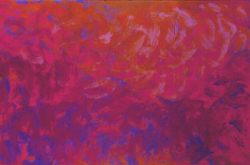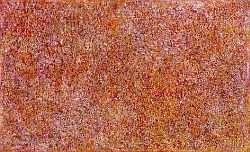Fig. 1: Gloria Tamerre Petyarre, Untitled, 1996, synthetic polymer paint on canvas, 117 x 176 cm, printed in: Aboriginal Art Galerie Bähr (ed.): Das Verborgene im Sichtbaren. The Unseen in Scene, 2. Aufl., Speyer 2002, exh. cat., p. 39
Fig. 2: Gracie Morton Ngale, Anwekety Country, 1999, synthetic polymer paint on canvas, 150,5 x 91,5 cm, printed in: Aboriginal Art Galerie Bähr (ed.): Das Verborgene im Sichtbaren. The Unseen in Scene, 2. Aufl., Speyer 2002, exh. cat., p. 30
On the Question of Abstraction
in Indigenous Art
The term abstract art is often applied to Indigenous Australian art. What, however, does the European art profession mean by the term? Consider the definition of abstract art used by Richard Gassen, former director of the Wilhelm-Hack public art gallery in Ludwigshafen, in his 1994 exhibition catalogue “Die Neue Wirklichkeit. Abstraktion als Weltentwurf“ (1):
“Whatever direction artists follow in abstract painting, they are united by their rejection of describing the tangible reality, rejecting the mimetic depiction [of reality]… Abstract paintings deal with the non-visible, they are internal pictures, visualizations of internal reality, which evade a figurative, representational depiction.” (translated by E.B.)
So far, this could also be a description of aspects of Indigenous art. Richard Gassen continues, however:
“History and narrative are replaced by immanently art-oriented questions of form and colour; a ‘pure’ or ‘absolute’ art is aimed for, which can evolve independently from the perceived reality.”
Recalling the discussion of relations between Jukurrpa and painting, described in the section on Jukurrpa, we recognize that Indigenous art has nothing in common with Abstract Art as it is defined in western European art.
The Indigenous artists use their paintings to describe and promulgate their view of the world, the Jukurrpa, and its constituent oral histories. The oral traditions can relate to laws or rules for society, to love or death, to topics of medicine, water sources, the Creation, political events of persecution or other crucial aspects of life. It is a narrative artform.
 Even artworks which at first sight seem abstract, like the 1996 painting “Untitled” by Gloria Tamerre Petyarre, can be inspired by oral histories, as in this work which references Awely, important religious ceremonies for women, which are accompanied by body painting and are connected with the Mountain Devil Lizard. Furthermore, the theme is closely connected to the country, Atnangkere and Alhalkere, of the artist’s father.
Even artworks which at first sight seem abstract, like the 1996 painting “Untitled” by Gloria Tamerre Petyarre, can be inspired by oral histories, as in this work which references Awely, important religious ceremonies for women, which are accompanied by body painting and are connected with the Mountain Devil Lizard. Furthermore, the theme is closely connected to the country, Atnangkere and Alhalkere, of the artist’s father.
Gloria Tamerre Petyarre paints turbulent blue, irregular arcs with a very broad brush on a fiery background in different shades of red, inspired by the rough textured skin of the Mountain Devil lizard. The colours pulsate, and the painting glows and is filled with life. The artist does not entitle her painting, but it is obvious that the topic or the emotions involved are powerful.
 "Anwekety Country", a work by Gracie Morton Ngale, is even more simplified than the painting by Gloria Tamerre Petyarre. Except for the colour nuances in the dots, no structures are visible. Nevertheless, it portrays the same themes that are present in more symbolicly explicit works.
"Anwekety Country", a work by Gracie Morton Ngale, is even more simplified than the painting by Gloria Tamerre Petyarre. Except for the colour nuances in the dots, no structures are visible. Nevertheless, it portrays the same themes that are present in more symbolicly explicit works.
The painting depicts an area near the Arlperre rockhole and soakage, near the banks of the Sandover River. In times past, this area produced sufficient uncultivated provender to nourish several family groups. Flooding of the river had led to enormous areas of fertile land and resulted in wide swathes of the violet-coloured Anwekety (wild plum, conkerberry or carissa spinarum), on which nutritious berries would mature immediately after rain. This bush is one of the most esteemed in the area of Arlperre, and it is the inspiration behind the Anwekety Altyerre (2), the most important ceremony belonging equally to women and men.
These examples illustrate that the putatively abstract form(s) in the compositions are actually expressions of a narrative occurrence.
Notes
(1) Gassen, Richard W. (ed.): Die neue Wirklichkeit: Abstraktion als Weltentwurf, Ludwigshafen 1994, exh. cat., p. 52
(2) Altyerre is, in the language of the Anmatyerre people, to whom Gloria Tamerre Petyarre and Gracie Morton Ngale belong, the term for Jukurrpa.
